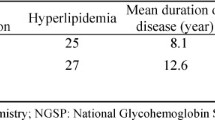Abstract
The aims of the study are (1) assessment of cell surface expression of adhesion molecules CD11b and CD62L on peripheral blood neutrophils in patients with type 2 diabetes and microangiopathy; (2) analysis of serum levels of soluble adhesion molecules: E-selectin (sE-selectin), soluble intercellular adhesion molecule-1 (sICAM-1), soluble vascular cell adhesion molecule-1 (sVCAM-1) and von Willebrand factor (vWF) and; (3) evaluation of systemic inflammatory markers like interleukin-6 (IL-6), soluble interleukin-6 receptor (IL-6Rs), high sensitivity C-reactive protein (hsCRP) and fibrinogen. Thirty patients with type 2 diabetes and microangiopathy were enrolled in the study. The study group was compared to 22 patients with type 2 diabetes without microangiopathic compliations. The control group included 20 healthy volunteers. Flow cytometry was used to analyse surface expression of adhesion molecules. Both inflammatory markers and soluble adhesion molecules were determined by immunoenzymatic assay. A significant increase in neutrophil surface CD11b expression (P < 0.01) as well as decrease in surface CD62L expression (P < 0.01) were observed in the group with diabetic microangiopathy in comparison with diabetic group without microangiopathic complications and healthy controls. Moreover, significantly higher concentrations of sICAM-1 (P < 0.05), sVCAM-1 (P < 0.05), sE-selectin (P < 0.05), vWF (P < 0.01), hsCRP (P < 0.01), IL-6 (P < 0.01) and fibrinogen (P < 0.001) were also found in patients with microangiopathy in comparison with the control group. IL-6Rs concentrations did not significantly vary between groups. We concluded (1) diabetic microangiopathy is accompanied by increase in CD11b expression and decrease in CD62L expression on peripheral blood neutrophils; (2) in diabetic microangiopathy rise in CD11b expression indicates neutrophil activation and intensified adhesion; (3) the development of diabetic microangiopathy is accompanied by an increase in soluble adhesion molecules and inflammatory markers concentrations in the blood.

Similar content being viewed by others
References
Bullo M, Garcia-Lorda P, Megias I, Salas-Salvado J (2003) Systemic inflammation, adipose tissue tumor necrosis factor, and leptin expression. Obes Res 11:525–531
MacKinnon JR, Knott RM, Forrester JV (2004) Altered L-selectin expression in lymphocytes and increased adhesion to endothelium in patients with diabetic retinopathy. Br J Ophthalmol 88:1137–1141
Barouch FC, Miyamoto K, Allport JR (2000) Integrin-mediated neutrophil adhesion and retinal leukostasis in diabetes. Invest Ophthalmol Vis Sci 41:1153–1158
Joussen AM, Poulaki V, Le ML et al (2004) A central role for inflammation in the pathogenesis of diabetic retinopathy. FASEB J 18:1450–1452
Adamis AP (2002) Is diabetic retinopathy an inflammatory disease? Br J Ophthalmol 86:363–365
Sassy-Prigent C, Heudes D, Mandet C et al (2000) Early glomerular macrophage recruitment in streptozotocin-induced diabetic rats. Diabetes 49: 466–475
Chow FY, Nikolic-Paterson DJ, Atkins RC, Tesch GH (2004) Macrophages in streptozotocin-induced diabetic nephropathy: potential role in renal fibrosis. Nephrol Dial Transplant 19:2987–2996
Heinzelmann M, Mercer-Jones MA, Passmore JC (1999) Neutrophils and renal failure. Am J Kidney Dis 34:384–399
Galkina E, Ley K (2006) Leukocyte recruitment and vascular injury in diabetic nephropathy. J Am Soc Nephrol 17:368–377
Fusman R, Rotstein R, Zeltser D et al (2001) The state of leukocyte adhesiveness/aggregation in the peripheral blood of patients with type 2 diabetes and ischemic vascular disease. Acta Diabetol 38:43–49
Rao KM, Hatchell DL, Cohen HJ (1997) Alterations in stimulus-induced integrin expression in peripheral blood neutrophils of patients with diabetic retinopathy. Am J Med Sci 313:131–137
Ruberg FL, Loscalzo J (2004) Inflammation and atherothrombosis. In: Loscalzo J (ed) Molecular mechanisms of atherosclerosis. Taylor & Francis, London, pp 45–60
Wierusz-Wysocka B, Zozulińska D, Wysocki H (2002) Odczyn zapalny w patogenezie mikro- i makroangiopatii cukrzycowej. Diabetologia 1:56–62
Gołąb J (2005) Krążenie limfocytów. In: Jakóbisiak M (ed) Immunologia. PWN, Warszawa, pp 103–117
Schröder S, Palinski W, Schmid-Schönbein GW (1991) Activated monocytes and granulocytes, capillary nonperfusion, and neovascularization in diabetic retinopathy. Am J Pathol 139:81–100
Oostrom AJ, Wijk JP, Sijmonsma TP et al (2004) Increased expression of activation markers on monocytes and neutrophils in type 2 diabetes. Neth J Med 62:320–324
Berliner S, Rogowski O, Rotstein R, Fusman R et al (2000) Activated polymorphonuclear leukocytes and monocytes in the peripheral blood of patients with ischemic heart and brain conditions correspond to the presence of multiple risk factors for atherothrombosis. Cardiology 94:19–25
Delamaire M, Maugendre D, Moreno M et al (1997) Impaired leukocyte functions in diabetic patients. Diabet Med 14:29–34
Grykiel K, Zozulińska D, Kostrzewa A et al (2001) Ocena ekspresji receptorów powierzchniowych na granulocytach obojętnochłonnych u chorych na cukrzycę typu 1. Pol Arch Med Wewn 5:377–381
Caimi G, Montana M, Ferrara F et al (2003) Polymorphonuclear leukocyte integrin pattern, at baseline and after activation, in type 2 diabetic subjects with macrovascular complications. Acta Diabetol 40:14–19
Danielsson P, Truedsson L, Eriksson K-F, Norgren L (2005) Inflammatory markers and IL-6 polymorphism in peripheral arterial disease with and without diabetes mellitus. Vasc Med 10:191–198
Fogelstrand L, Hulthe J, Hulten LM et al (2004) Monocytic expression of CD14 and CD18, circulating adhesion molecules and inflammatory markers in women with diabetes mellitus and impaired glucose tolerance. Diabetologia 47:1948–1952
Zalecenia kliniczne dotyczące postępowania u chorych na cukrzycę (2005) Stanowisko Polskiego Towarzystwa Diabetologicznego. Diabetologia Doświadczalna i Kliniczna 2004; 4, sup.E
Lutty GA, Cao J, McLeod DS (1997) Relationship of polymorphonuclear leukocytes to capillary dropout in the human diabetic choroid. Am J Pathol 151:707–714
Smalley DM, Ley K (2005) L-selectin: mechanisms and physiological significance of ectodomain cleavage. J Cell Mol Med 9:255–266
Declaration of competing interests
None to declare.
Author information
Authors and Affiliations
Corresponding author
Rights and permissions
About this article
Cite this article
Mastej, K., Adamiec, R. Neutrophil surface expression of CD11b and CD62L in diabetic microangiopathy. Acta Diabetol 45, 183–190 (2008). https://doi.org/10.1007/s00592-008-0040-0
Received:
Accepted:
Published:
Issue Date:
DOI: https://doi.org/10.1007/s00592-008-0040-0




